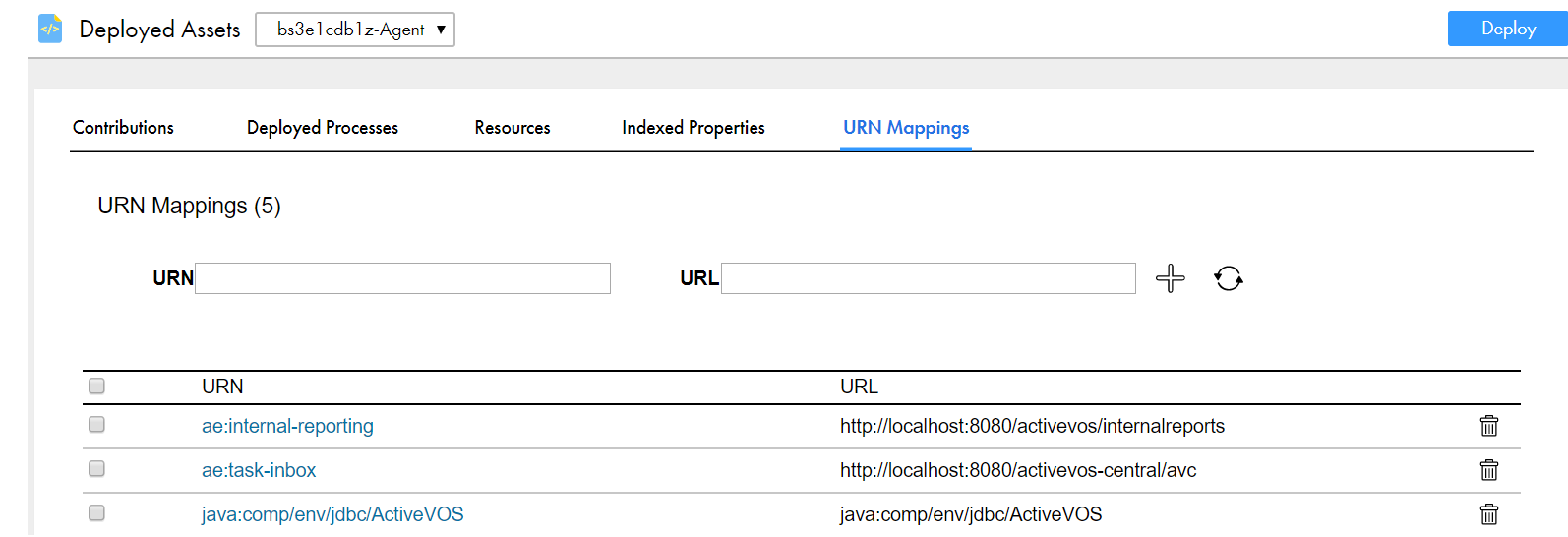On the URN Mappings
tab
, there are system mappings and user-defined mappings.
You see four default mappings if you select a Secure Agent.
The following image shows a sample URN Mappings
tab
:
Process Server provides the following default URN Mappings for system services. You may need to manually add a mapping if it wasn't part of your initial configuration.
|
http://localhost:8080/activevos/internalreports
Default address of the BIRT reporting engine for a deployed process containing a reporting service.
|
|
http://localhost:8080/activevos-central/avc
Default address of Process Central. Be sure to change the
host:port
to match your installed location, if needed.
|
j java:comp/env/jdbc/ActiveVOS
|
This value is created using your specified JNDI database name
|
urn:aeHostEnvironmentRuntime
| avHostEnvironmentRuntimeAccess
|
You can assign a physical address to a universal resource name (URN). The URN is a logical address of a partner link, specified in a deployment resource.
URN mappings provide a flexible and dynamic way to define target endpoint references. Use URN mappings to specify the physical address of a partner link endpoint reference instead of using the address specified in a process deployment descriptor (.
pdd
) file or WSDL file. By mapping a URN to a URL, you do not have to rely on invoking a statically defined endpoint address. URN mappings give you flexibility, for example, to deploy the same BPR files for testing and production environments.
Also, if you specify a URL, you can replace the URL by mapping it to a different URL.
The following example illustrates one type of URN to URL mapping:
urn:localhost = http://localhost:8080/active-bpel/services/${urn.3}
This mapping might be used when a process is deployed with the following partner link address information:
<partnerLink name="assessor">
<partnerRole endpointReference="static"
invokeHandler="default:Address">
<wsa:EndpointReference xmlns:assessor="http://
tempuri.org/services/loanassessor">
<wsa:Address>urn:localhost:AssessRisk</wsa:Address>
<wsa:ServiceName PortName=
"SOAPPort">assessor:LoanAssessor</wsa:ServiceName>
</partnerRole>
</partnerLink>
The Process Server invocation framework resolves the URN as follows:
urn:localhost:AssessRisk = http://localhost:8080/active-bpel/services/AssessRisk
Here are some ways you can map URNs to URLs. Note that each segment of the URN is separated by a colon.
|
http://localhost:8080/active-bpel/services/MyService
|
http://ServerA:8080/active-bpel/services/MyService
|
http://ServerB:8081/active-bpel/services/MyService
|
|
http://localhost:${AE-NODE1-PORT}/active-bpel/services/${urn.4}
|
The last example in the table above shows how you can use variable substitution in an URL.
The URL values can optionally contain variables. The variables can be environment variables accessible through
java.lang.System.getProperties()
or a segment from the URN itself. The Apache Ant style variable declaration of
${property}
is used to identify a property within the URL. Segments from the input URN value can be referenced by using a special property naming convention of
${urn.offset}
where offset is a one-based offset identifying the segment from the input URN value to use for substitution.
The URL in the third mapping in this table contains two variables. The
${AE-NODE1-PORT}
variable pulls the port number from an environment variable. This variable would need to be set as a -D parameter on the Java runtime environment (for example,
java -D AE-NODE1-PORT =8080 ...
) or populated externally to the Process Server.
The
${urn.4}
variable, also in this example, references the fourth segment from the input URN value. Notice that the URN contains only three segments. The URN in the
.pdd
file should contain at least one other segment. A sample URN might be:
urn:localhost:service:StoreService
.
As the value of the fourth segment of this URN is
StoreService
, the resulting URL is:
http://localhost:8080/active-bpel/services/StoreService/
Operations you can perform are:
Add a new URN, fill in the URN and URL fields within the Add new URN Mapping section and then press the
Add/Update Mapping
button.
Edit an existing URN, click on its link in the top area of this
tab
. Process Server fills in the URN and URL fields within the Add new URN Mapping section. After making changes, press the
Add/Update Mapping
button.
To delete a mapping, select the check box next to the mapping and select
Delete
.

